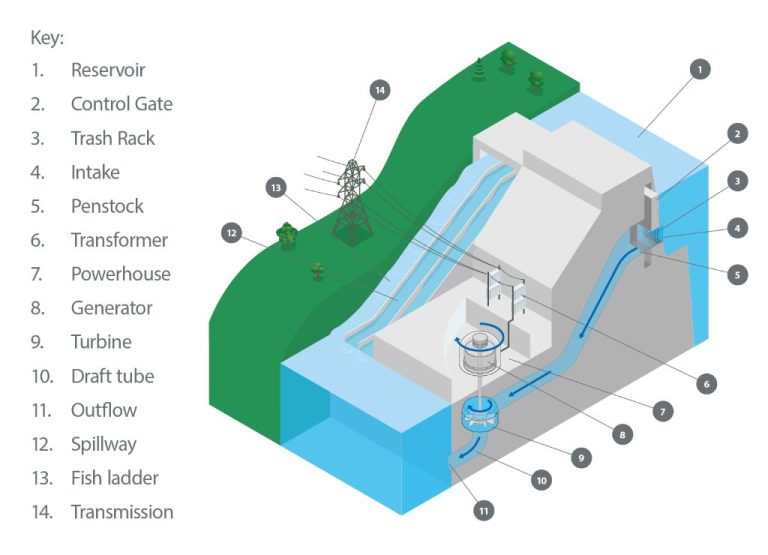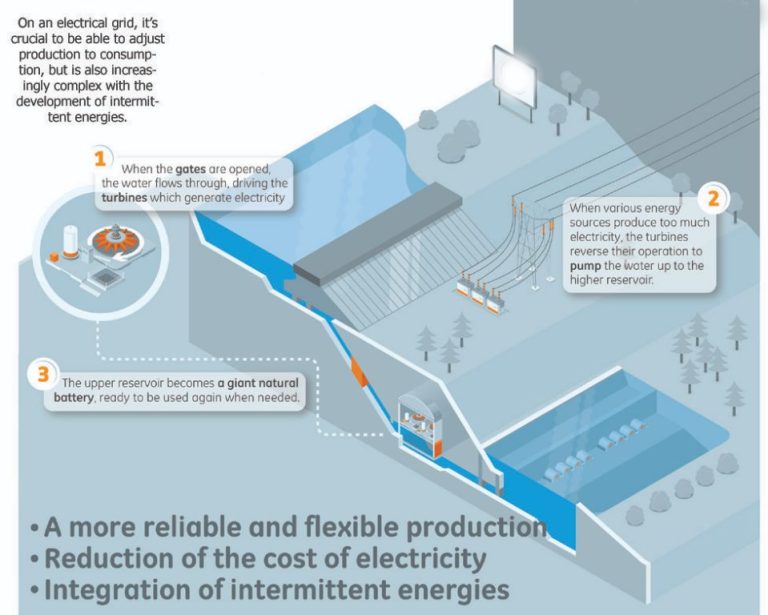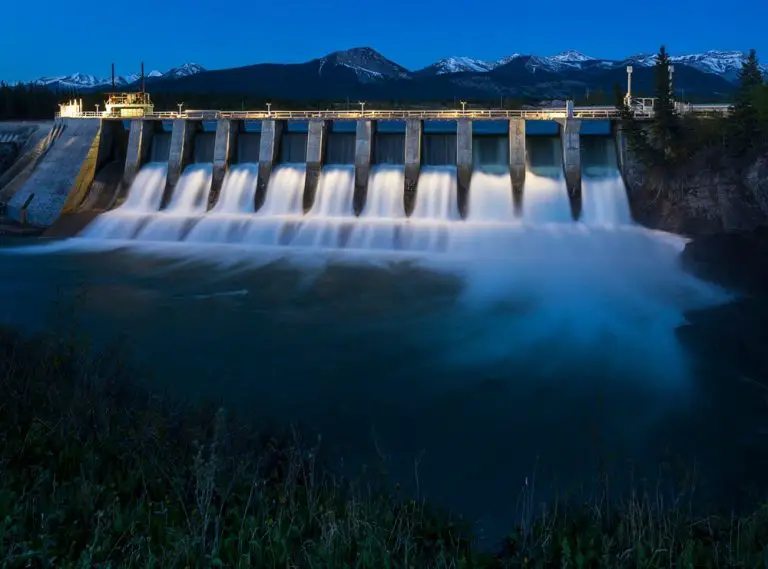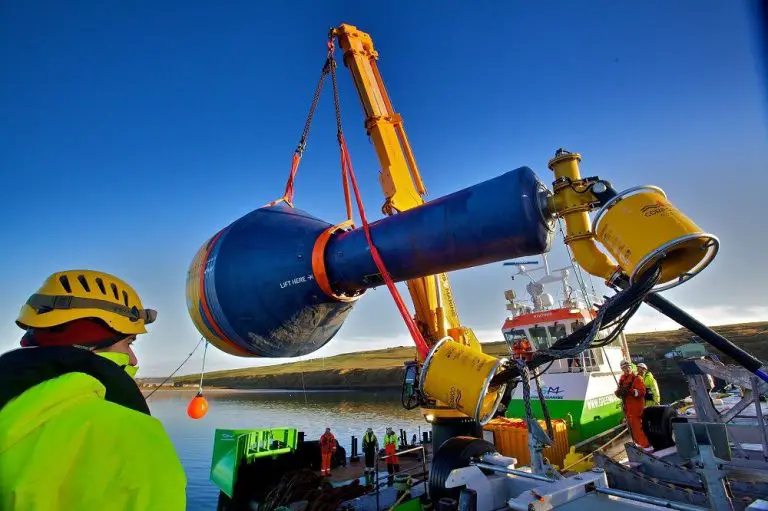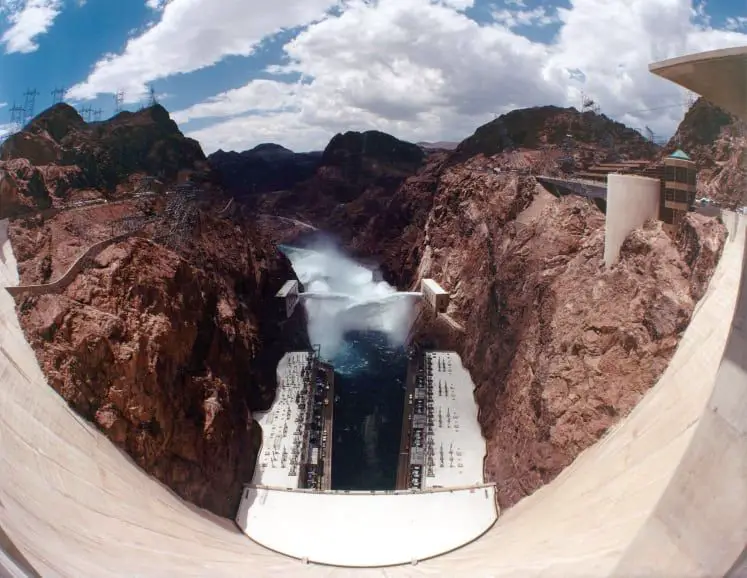What Is Hydroelectric Power In A Sentence?
Definition of Hydroelectric Power
Hydroelectric power, also known as hydropower, is electricity generated through the energy of flowing water. It is considered a renewable energy source since water can be used repeatedly to generate electricity. Hydroelectric power plants capture the kinetic energy of flowing water by directing it through large turbines connected to electricity generators. The moving water spins the turbines, which then spin coils of copper wire inside the generators. This creates an electric current that is captured and delivered through transmission lines to homes, businesses, and industries.
In short, hydroelectric power is electricity generated by water flowing through turbines connected to generators. The kinetic energy of the moving water is converted into usable electricity that powers our modern world. It is one of the oldest and most widely used forms of renewable energy.
How Hydroelectric Power Works
Hydroelectric power is generated by using the natural flow of water to produce electricity. Rivers or man-made reservoirs with dams are used to create a water source at a higher elevation. When the water is released from the reservoir, it flows through large pipes called penstocks. The flowing water spins turbines at a power plant below the dam. The motion of the turbines spinning generates electricity through electromagnetism.
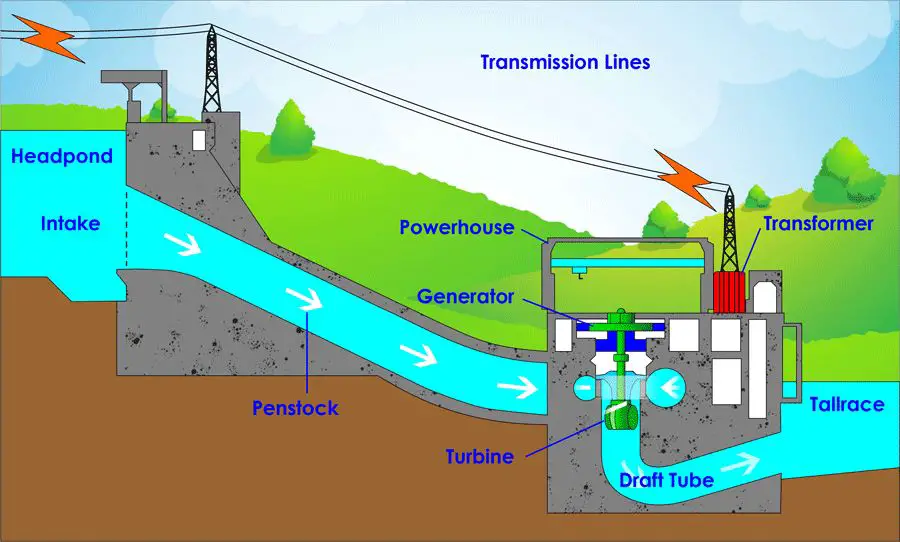
The amount of electricity that can be generated depends on both the volume of water flow and the vertical distance the water falls. More electricity can be produced with a greater volume of water or a larger ‘head’ – the height difference between the water source and water intake at the power plant. Dams help create an artificial lake or reservoir with a large head height to produce more power.
After the water passes through the turbines, it flows out on the downstream side of the dam. Hydroelectric plants provide a renewable source of energy that takes advantage of gravity and the water cycle to reliably produce electricity.
Benefits of Hydroelectric Power
Hydroelectric power offers several important benefits that make it an attractive energy source. Most significantly, hydroelectric power is a renewable energy source. It relies on the water cycle, which is continuously renewed through evaporation and precipitation. As long as there is flowing water, hydroelectric power can be generated.
Hydroelectric power plants also produce no direct waste and emit no greenhouse gases. After the initial infrastructure is built, the source of the electricity (flowing water) is clean. With global climate change and carbon emissions being major concerns today, hydroelectric power offers a huge advantage over fossil fuels that emit greenhouse gases like carbon dioxide and methane.
Limitations of Hydroelectric Power
While hydroelectric power is a renewable energy source with many benefits, it does have some limitations to consider. Two major limitations are the expensive dams required and the potential impact on rivers and wildlife.
Constructing large dams and reservoirs necessary for most hydroelectric plants requires substantial investment and can have environmental impacts. The costs involved with site selection, engineering, materials, construction, and transmission infrastructure make it one of the most capital intensive energy sources. These high upfront costs can take decades to recoup.
Dams also profoundly affect river systems and ecosystems. The damming of rivers for hydroelectric power can influence water quality, change natural water temperatures, restrict fish migration and spawning, reduce downstream sediment transport, and alter downstream river channel morphology. This can negatively impact local wildlife and vegetation. Some reservoirs may cover important natural habitat or agricultural land. Proper siting, planning, and mitigation measures can help address some of these river ecosystem concerns.
Major Hydroelectric Power Countries
Several countries around the world rely heavily on hydroelectric power as part of their energy mix. The top countries that utilize hydroelectric power include:
- China – China has invested heavily in hydroelectric power plants and dams over the past few decades and now has over half of the world’s large hydro capacity. Major projects like the Three Gorges Dam on the Yangtze River provide substantial renewable electricity for China’s population centers.
- Brazil – Brazil gets around two-thirds of its electricity from hydroelectric sources, including massive dams like Itaipu on its border with Paraguay which is one of the largest power stations in the world. Brazil has excellent hydro resources in the Amazon basin.
- Canada – With its wealth of rivers and lands well-suited for dams, Canada is one of the top hydro producers globally. Major facilities are found in Quebec, British Columbia, Manitoba and other provinces.
- United States – While not as dominant as in some countries, hydro still provides around 7% of U.S. power. Large dams out west along the Colorado River, Columbia River and other waterways generate significant renewable electricity.
- Russia – Russia has an abundance of hydroelectric potential in Siberia and other areas. Mega projects like the dams along the Angara River supply power to Russian cities and industry.
Largest Hydroelectric Dams
Some of the largest hydroelectric dams in the world include the Three Gorges Dam in China, the Itaipu Dam on the Brazil/Paraguay border, and the Guri Dam in Venezuela. These massive dams exemplify the tremendous power generation capabilities of hydroelectricity when harnessed at a grand scale.
The Three Gorges Dam on the Yangtze River in China is the world’s largest power station in terms of installed capacity at 22,500 megawatts. Completed in 2006 after nearly 20 years of construction, this massive dam spans over a mile wide and towers over 600 feet tall. The reservoir itself stretches over 350 miles and displaces over 1 million people.
The Itaipu Dam on the Paraná River bordering Brazil and Paraguay is the second largest hydroelectric power station in the world at 14,000 megawatts of installed capacity. Completed in 1984 after 12 years of construction by Brazil and Paraguay, Itaipu supplies over 90% of Paraguay’s electricity and meets about 15% of Brazil’s demand.
Rounding out the top three is the Guri Dam in Venezuela on the Caroni River. With an installed capacity of 10,200 megawatts, Guri supplies roughly 73% of Venezuela’s electricity since its completion in 1986 after 7 years of construction. The Guri reservoir is one of the largest lakes in South America.
Small Scale Hydroelectric Power
In addition to large hydroelectric dams, there are many small-scale hydroelectric power projects that can provide electricity on a community or individual scale. These small-scale projects take advantage of smaller water resources like streams, canals, or small rivers to generate electricity. There are three main types of small-scale hydroelectric power:
Run-of-river hydroelectric plants channel a portion of a river’s water through a canal or penstock to spin a turbine. These systems do not require large dams or reservoirs, as they rely on the natural flow of the river. Run-of-river systems have minimal environmental impact compared to large hydro dams. However, their power output fluctuates seasonally depending on water flow.
Micro hydro systems produce up to 100 kW of electricity by harnessing small perennial mountain streams with a head of at least 2-3 meters. The water from the stream is diverted through a pipeline or channel to spin a turbine. Micro hydro systems provide clean, low-cost electricity for isolated rural communities not connected to the grid.
Pico hydro refers to hydroelectric plants producing less than 5 kW of power. These small systems can provide electricity for a single home, farm, or small business. The pico hydro turbine is often connected directly to an electrical appliance or battery charging system. Pico hydro relies on small waterfalls or high head run-of-river sites. It provides a low-cost power solution for remote locations.
Small scale hydroelectric projects have minimal environmental impact compared to large dams. They provide clean renewable electricity and energy access to rural communities. With small rivers and streams abundant worldwide, small hydro has great potential for localized renewable electricity generation.
Hydroelectric Power Storage
One way hydroelectric power plants can help meet variable electricity demand is through pumped storage hydroelectricity. This involves storing energy by pumping water from a lower reservoir uphill to an upper reservoir. During periods of high electricity demand, this stored water can then be released from the upper reservoir back downhill through turbines to generate extra power.
Pumped storage hydro allows energy from erratic but renewable sources like wind and solar to be captured for later use. The towers of pumped storage stations often resemble those of conventional dam-style hydroelectric plants.
However, pumped storage systems do not use naturally elevated water sources like rivers or lakes. Instead they cycle water between artificial reservoirs, often reversing flow direction depending on energy needs. Overall, pumped hydro provides a reliable means of load balancing and energy storage for power grids.
Hydroelectric Power and the Environment
Hydroelectric power can have significant environmental impacts, especially on fish migration and habitat flooding. The dams required for hydroelectric facilities often block fish from reaching upstream spawning grounds. Fish ladders and elevators can help mitigate this, but are not always effective. The reservoirs created by dams also flood large areas upstream, altering or destroying riparian and riverine habitats. Studies show hydroelectric dams reduce biodiversity and change ecosystem dynamics through habitat loss and fragmentation.
In some cases, hydroelectric projects require deforestation and the loss of terrestrial ecosystems. And greenhouse gas emissions may occur from the decomposition of vegetation and carbon in flooded areas. Projects in tropical regions are especially concerning, as they can impact rainforest habitats. On the other hand, hydroelectricity has lower lifecycle emissions than fossil fuel sources. Overall, the environmental effects must be weighed against the benefits of renewable hydroelectric power generation.
Future of Hydroelectric Power
Hydroelectric power will continue to play an important role in the renewable energy mix going forward. While most major sites in developed countries have already been utilized for hydroelectric dams, there is still potential to expand hydropower, especially in developing countries.
Some of the advances that will shape the future of hydroelectric power include:
- New turbine technologies like variable-speed turbines that improve efficiency.
- Pumped storage hydropower that works by pumping water uphill to a reservoir during periods of low electricity demand, then releasing it through turbines when electricity demand is high.
- Small-scale and low-head hydro projects that utilize smaller rivers and streams.
- Upgrades and capacity expansions at existing facilities.
- Floating solar PV systems installed on dam reservoirs that allow for hydro and solar power generation at the same site.
- Hybrid solutions that combine hydroelectric power with wind, solar, biomass, and other renewables for more flexibility.
With the right policies and investments, hydroelectricity can continue expanding as part of diverse renewable energy portfolios, helping balance intermittent sources like wind and solar while providing grid reliability services.

